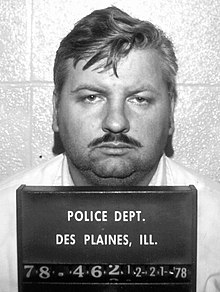In the late 1970s, John Wayne Gacy, an infamous serial killer, shocked the world and dominated headlines with a series of gruesome crimes. Before he was arrested and convicted for the murder of 33 young men and boys, Gacy was already making headlines due to a sodomy charge against him. This charge was just the beginning of Gacy’s chilling and terrifying criminal career, which ultimately led to his death by lethal injection in 1994.

Aside from the monstrous acts he committed, Gacy became known for his double life. He was a successful business owner and prominent community figure, regularly performing as “Pogo the Clown” at charitable events and children’s parties. It’s this façade that allowed him to continue his killing spree and evade police suspicion for so long. Today, we’ll delve into Gacy’s life and try to decipher the events leading up to his first criminal charge of sodomy, understanding the pivotal role it played in the grand scheme of his shocking past.
Digging deeper into Gacy’s background, we aim to uncover the various factors that contributed to his criminal behavior. Were there early warning signs that went unnoticed, or did his public persona allow him to fly under the radar? By comprehending the factors that led to Gacy’s sodomy charge, we can better understand how his criminal activities amplified over time, ultimately unfolding to reveal one of the most notorious serial killers in American history.
Understanding John Wayne Gacy’s Sodomy Charge
John Wayne Gacy, also known as the Killer Clown, was a notorious American serial killer responsible for the deaths of at least 33 young men and boys during the 1970s in the Chicago area. But before his murderous spree, he faced a sodomy charge that hinted at the violent monster lurking beneath his seemingly upstanding exterior. Let’s dive into the details of this early sign of Gacy’s criminal inclinations.
Before Gacy became known as one of the most brutal serial killers in American history, he was a well-liked figure in his community, even performing as a clown at children’s hospitals and charity events. However, his seemingly normal life was shattered when he was charged with sodomy in 1968.
The charge stemmed from a troubling incident in which Gacy, then living in Waterloo, Iowa, coerced one of his employees – a 15-year-old boy – into engaging in sexual acts by threatening him with a knife. The boy ultimately reported the assault to law enforcement, leading to Gacy’s arrest.
- It was discovered that Gacy had several other victims, some of whom testified against him during the trial.
- Gacy was a sexual sadist, taking pleasure in both inflicting and receiving pain during these encounters.
- He was highly skilled at manipulation and deceit, using his charm and authority to control the lives of his victims.
Some key points regarding the conclusion of Gacy’s sodomy case:
- Despite maintaining his innocence, Gacy was found guilty and sentenced to 10 years in prison.
- He was released on parole after serving just 18 months, primarily due to his behavior as a model prisoner.
- The early release of Gacy set the stage for the horrendous acts he would commit in the years following his release.
Gacy’s sodomy charge was a significant turning point in the life of the future serial killer. It foreshadowed the violence and psychological control that would become his trademarks as he continued to prey on young men and boys during the next decade.
By examining this early crime, we can gain a deeper understanding of the dark path taken by John Wayne Gacy – and how the aftermath of this case may have shaped the ruthless killer that lurked within.
A Closer Look at Gacy’s Criminal History
John Wayne Gacy is a name that sends shivers down the spines of those familiar with cold cases, crime, and mystery. As we delve into Gacy’s criminal past, sodomy charges make an appearance in our findings.
Before gaining notoriety as the Killer Clown, Gacy’s first known encounter with the law was in 1968. He was charged with sodomy involving a teenage boy in Waterloo, Iowa. It’s important to understand the events that transpired, unfurling Gacy’s dark history, and his transition into a notorious serial killer.
During the time of the charge, Gacy was married and well-liked in his community. He managed several restaurants, where he would often employ teenage boys. It was through these connections that Gacy found his first victim, 15-year-old Donald Voorhees. Gacy was accused of luring Voorhees to his home with the promise of showing him pornographic films. Once there, Gacy drugged, sexually assaulted, and ultimately sodomized the young boy.

Upon being reported to the authorities, Gacy was charged with sodomy. His criminal lair came apart as more victims emerged, alleging similar accounts of assault. Some noteworthy details of Gacy’s criminal history include:
- Gacy’s sodomy charge led to a 10-year prison sentence, but he was released after only 18 months for good behavior.
- Following his release, Gacy remarried and relocated to the Chicago area. His violent tendencies were far from diminished – they only escalated.
- In the years that followed, Gacy went on to commit at least 33 murders, targeting young men and boys.
- His modus operandi involved luring his victims into his home, where he would assault, torture, and murder them.
Gacy’s sodomy charge was not an isolated incident, but rather a warning sign of the atrocities that lay ahead. Although he managed to avoid suspicion for a while, it was only a matter of time before his true nature surfaced, and law enforcement eventually caught up with him.
In sum, it’s vital to take a closer look at John Wayne Gacy’s criminal history – from his sodomy charges to his gruesome serial killings. His case offers an unsettling reminder of the darkness hidden within seemingly ordinary individuals and the importance of thoroughly investigating warning signs. The story of Gacy continues to serve as a haunting lesson for true crime enthusiasts, shedding light on a sinister past that has left an indelible mark on the annals of crime history.
The Turning Point: Gacy’s Trial and Conviction
When we take a close look at John Wayne Gacy’s life, one particular event marked the turning point in his criminal career – the trial and subsequent conviction on a sodomy charge. This section delves into the details of that life-changing moment and how it eventually led to Gacy’s exposure as one of America’s most notorious serial killers.
In 1968, Gacy faced trial after being charged with sodomy involving a 15-year-old boy. This would become a significant event in his life, shaping the path that eventually led to him becoming a serial killer. Up until this point, Gacy had held various community positions, including membership in the Jaycees organization, which is known for its positive impact on local communities.
Gacy’s trial exposed his dark side, revealing his violent and aggressive tendencies, as well as his prowess for manipulation. In a disturbing pattern, Gacy maintained his innocence throughout the trial, despite the victim’s account and other testimonies that painted a different picture.
Some notable moments from Gacy’s trial and conviction include:
- During the trial, Gacy claimed the sodomy charge was a result of a misunderstanding, portraying himself as the victim.
- The jury deliberated for only two hours before finding Gacy guilty and sentencing him to 10 years in prison.
- Gacy served only 18 months of his sentence, granted parole in 1970.
It’s vital to understand the implications of this trial, as the outcome influenced how Gacy perceived himself and his capacity for crime. The leniency of his parole contributed to his sense of invincibility, confirming in his mind that he could commit heinous acts and evade severe consequences.
Following his release, Gacy went on to commit at least 33 known murders between 1972 and 1978, which ultimately resulted in his arrest, trial, and conviction as a serial killer responsible for the deaths of numerous young men and boys. In 1980, he was found guilty on all counts and sentenced to death.
In summary, the turning point for John Wayne Gacy lies in his sodomy charge trial and subsequent conviction in 1968, which uncovered his violent tendencies and set the stage for his eventual criminal exposure as a terrifyingly efficient serial killer.
Conclusion: The Lasting Impact of Gacy’s Case
We’ll now discuss the lasting impact of John Wayne Gacy’s sodomy charge and how it has influenced society’s perception and understanding of serial killers. Gacy’s case has been a focal point in the world of cold cases, crime, and mystery enthusiasts for decades. Here’s how the case has left its mark on us:
- Lessons in law enforcement: Gacy’s case has served as a wake-up call for law enforcement agencies, highlighting the importance of thorough investigations and proper evidence collection. This has contributed to significant improvements in police procedures and techniques.
- Public awareness: Gacy’s notoriety has played a pivotal role in raising public awareness about the potential dangers lurking within society. It has also helped to dispel the myth that serial killers are only a figment of Hollywood fiction.
- Crime prevention efforts: The chilling reality of Gacy’s crimes has inspired numerous initiatives, both governmental and non-governmental, aimed at preventing similar situations from happening again. These include public safety campaigns, victim support programs, and increased funding for criminal investigative units.
- Impact on pop culture: Gacy’s case has inspired various movies, documentaries, books, and even songs that have captivated audiences worldwide. This has contributed to the continued fascination with Gacy and other notorious serial killers, fueling an unending curiosity in the realm of crime and mystery.
- Influence on criminal profiling: Gacy’s case played a significant role in the development of criminal profiling methodologies that have since become an essential part of law enforcement investigations. By studying Gacy’s behavior, motives, and patterns, experts have been able to develop more comprehensive profiles for potential serial killers, aiding in their apprehension.
In sum, the John Wayne Gacy sodomy charge’s lasting impact on society is indisputable. His case forever changed the way law enforcement handles serial killer investigations and has left a lasting impression on the audience of cold cases, crime, and mystery enthusiasts. The chilling details of his gruesome crimes continue to enthrall and educate, serving as a stark reminder of the dark side of humanity.
References:
https://www.britannica.com/biography/John-Wayne-Gacy

Owner & entrepreneur with a passion for murder mystery! Seriously, who doesn’t love murder mystery?
Chris is a proud member of the American Medical Writer’s Association (AMWA), the International Society for Medical Publication Professionals (ISMPP), the National Association of Science Writers (NASW), the Council of Science Editors, the Author’s Guild, and the Editorial Freelance Association (EFA).

